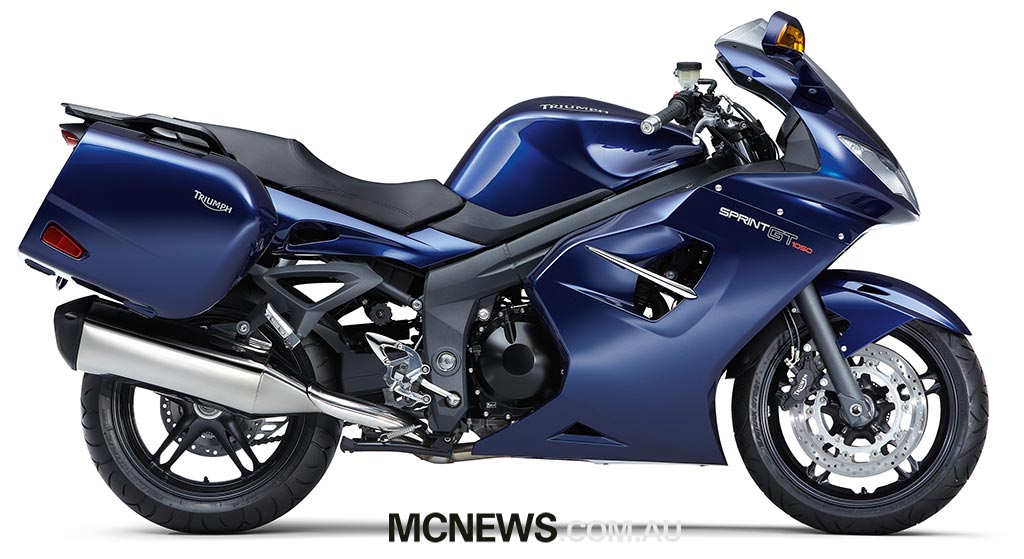Triumph Sprint GT Review
By Trevor Hedge
Triumph’s Sprint GT looks fairly bland and riding the bike for the first time I couldn’t help but think UJM. That unflattering descriptive acronym once so often used to describe Japanese motorcycles. A term of admonishment rather than endearment, UJM stands for Universal Japanese Motorcycle. Japanese motorcycles were seen by many as perfectly competent at everything, but overwhelmingly devoid of character. The term was more often used by riders of various European machines that were not very competent at anything. Thus I have always found it a particularly ironic idiom.
Still, no doubt plenty of people will be aghast at my describing a British motorcycle, a Triumph no less, as a modern day interpretation of the UJM. But I assure you, I am using it for the most part as a term of endearment. There is also no getting away from the fact that while the Sprint GT is competent and fantastic value for money, it is a little devoid of that soulful character some expect from a European machine.
It even seems the colour chart at the Triumph factory only offers various shades of bland with a subdued blue and a yet to arrive silver the only choices on offer.
Luckily the Sprint GT has plenty going for it to make up for its somewhat staid appearance.
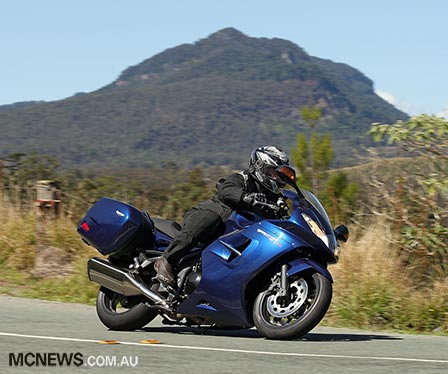
At only $15,990 with factory panniers, a grunty 1050 triple-cylinder engine, comfortable ergonomics and a surprisingly capable chassis, the Sprint GT really is more than the sum of its parts.
First launched in 1993 as a Sprint 900 the model then morphed into the Sprint 955i in 1998 before breaking the litre barrier in 2005 with the launch of the Sprint 1050. As time has progressed the Sprint has gotten more and more affordable in relation to its competitors and in its latest Sprint GT guise has morphed into one of the most capable sports-tourers on the market with nary a shortcoming in any significant area of performance.
The 1050cc triple responds well at all rpm with a useful top end. Obviously it has nowhere near the huge balls down low of larger engined bikes such as Suzuki’s GSX1250FA but it still gets the job done quite nicely and spins eagerly towards its 9,500 rpm rev-limiter. So much so that I regularly brushed the soft-touch limiter while enjoying the Mt Lindsay Highway and environs.
Triumph’s claimed maximum of 130hp at 9200rpm sounds about right. Torque has grown slightly for the new model year and arrives 1200rpm lower at 6300rpm. The engine has ample urge for every occasion and can make use of most of its 260km/h conventional speedometer if given free reign.
In an ideal world the engine would have a bit more oomph down low and a little more over-rev but overall I could certainly live with this engine, especially when housed in such a value packed offering as the Sprint GT.
Some people will put a black mark against the Sprint GT due to its chain final drive rather than shaft. In this day and age however chains last more than 25,000km with no lubrication and hardly ever require adjustment between tyre changes. Long gone are the days of needing to clean and lubricate chains all the time but the Sprint ST does boast a centre-stand to help aid the task.
While the Sprint GT has no shaft drive it does exhibit an uncomfortable level of backlash more common to that arrangement. It is not readily apparent in the hills or while shuffling up or down the box but is quite noticeable in the city while getting on and off the gas at low speed. It’s far from terrible, just not expected. The GT’s sixth gear is 7% taller than the outgoing ST model. At 110km/h the Sprint GT is purring along at less than 4000rpm. Continued….
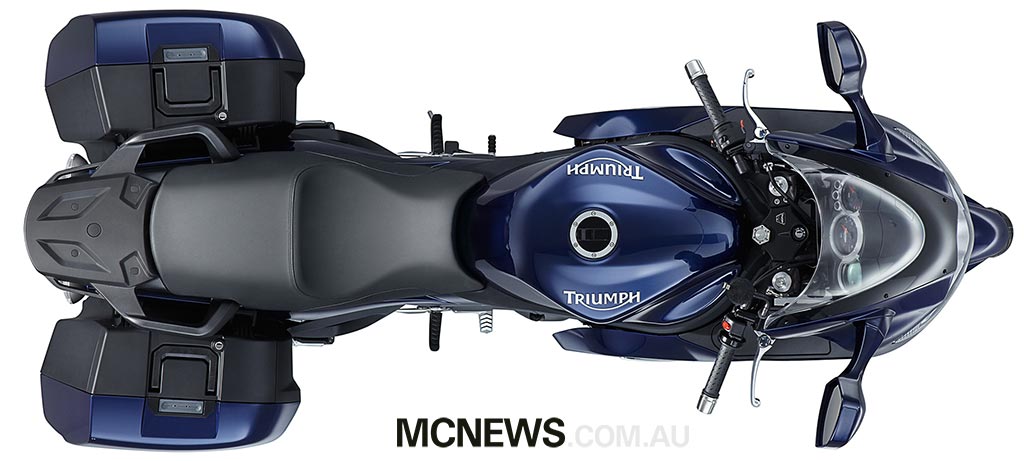
Showa supply the stiffer 43mm forks with a handy 127mm of travel and adjustable preload. The Japanese company also provides the preload and rebound damping adjustable rear shock absorber, also firmer than before. A hand-wheel allows for easy preload adjustment on the rear which due to the remarkably long 152mm of rear suspension travel proves quite an asset.
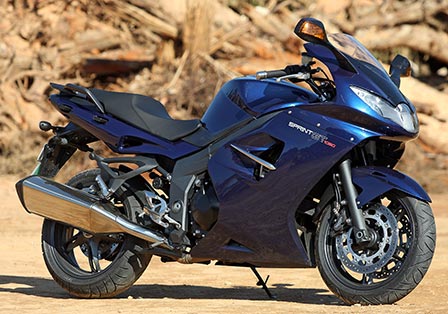
Undulating surfaces when pressing on in the hills produces a level of rear suspension travel much higher than more sports focussed machines but it is a testament to the Triumph’s damping that it never gets too unruly. And of course the comfort benefits on the long haul of such a generous amount of suspension travel can’t be overstated. Especially if you have to put up with the pockmarked pitiful excuse for bitumen that passes for roads in NSW. The Sprint GT offers 20mm more rear suspension travel than most competitors and a 215kg maximum load rating is nearly 20kg more generous than Honda’s VFR1200F.
Tying the Showa suspension together is a conventional aluminium beam perimeter frame carried over from the Sprint ST. It all comes together remarkably well to provide a level of sporting satisfaction that I must say I hadn’t expected.
The steering is quite light and direct and the Sprint GT is a joy to hustle through tight or open terrain. I felt at home from the first turn and rarely longed for more chassis performance than the Sprint GT provided. There is unquestionably plenty of sport in this sports-tourer.
Ground clearance is generous and I only felt the centre-stand bottom once. Certainly an animated riding style helps keep the undercarriage off the deck through the turns. Sit still like a sack of spuds then expect to carry the corner speed of a sportsbike and you will deck things out. Shift your arse around a bit to give the chassis half a chance and your sportsbike mates will not pull away at any significant rate.
Compared to the Sprint ST the new Sprint GT sports a slightly steeper rake and less trail to help counter the 108mm longer wheelbase and despite weighing 27kg more manages to feel sportier than its predecessor.
On the open road the Sprint GT also acquits itself remarkably well. My Shoei ensconced bonce was never buffeted or made uncomfortable and the suspension shrugged off the worst road irregularities to make me a happy camper. A 350km day was not really enough to see if the seat grows teeth after a long day in the saddle but I suspect it would acquit itself quite well on the long haul. Pillions are also well catered for.
A 20 litre fuel tank provides a 340km range on the highway and the remaining level is easily checked via a segmented fuel gauge on the dash and economy is monitored via a comprehensive trip computer complete with distance to empty.
The tachometer is centrally mounted and flanked by a hard to read speedometer on the left. With draconian speed enforcement it would have been nice to have the facility to switch the large LCD to display speed to help preserve your licence.
Both clutch and brake levers are span adjustable but even on their shortest setting I found them a little far away for my liking.
Stopping the show is an improved set of Nissin four-piston calipers clamping 320mm discs up front and a 255mm twin-piston rear. The brakes work very well indeed with the rear particularly deserving of high praise. With the lengthy rear suspension travel I found some use of the rear brake to help balance the bike through turns a useful aid. Even after quite a spirited session of corner carving the rear disc showed no signs of fade or discolouration. A well-tuned ABS system adds a handy measure of safety. Continued…
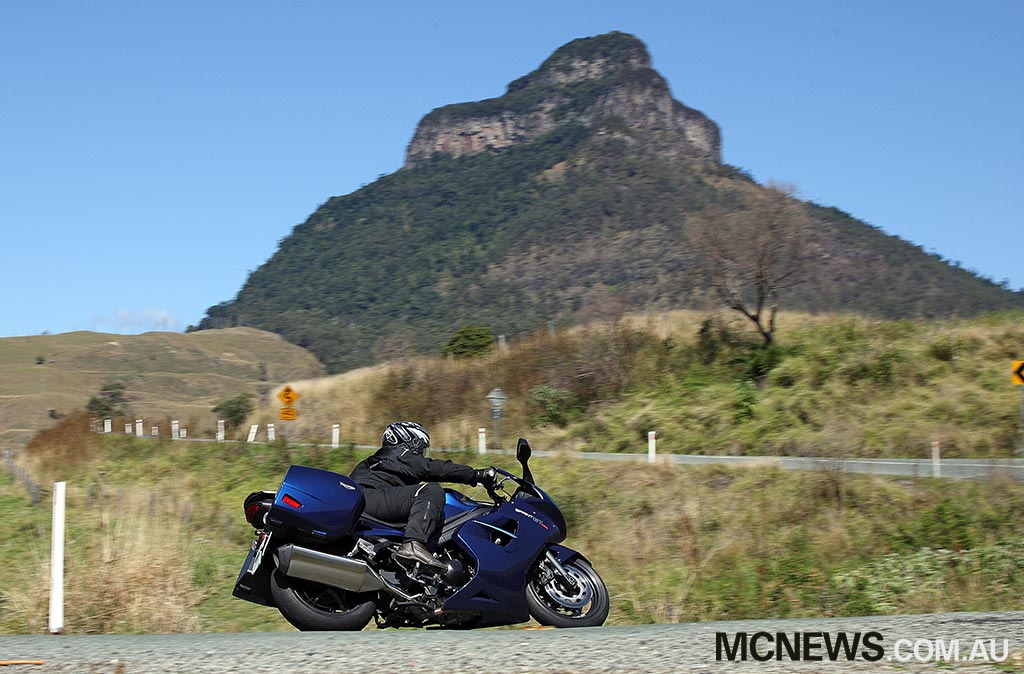
Voluminous 31-litre side panniers are standard on the $15,990 Sprint GT and add a wonderful level of versatility to the bike.
The panniers do hang out in the breeze somewhat and make the rear of the machine much wider than the front. Thus lane-splitting with the panniers on would be a dangerous exercise.
The Sprint GT panniers are nine litres larger per side than those fitted to the Sprint ST. The headlight is also of a new design claimed to be much brighter but we were unable to put that to the test on the launch ride.
An optional 55-litre top-box complete with 12 volt power outlet can be purchased for around $900. All luggage is keyed alike to the ignition for convenience and a backrest can be added to the top-box. Other options include a lower seat, a gel seat, higher screen and inner bags for the panniers. A range of magnetic tank bags can also be fitted to the Sprint GT if you feel the need for even more storage.
The move to a conventional side mount muffler from under-seat pipes has also opened up some useful room under the seat. Enough space to store a tyre repair kit or a thin set of waterproofs. This adds to the convenience of the small storage compartment in the front fairing that can swallow a phone, wallet and e-tag etc.
The Sprint GT does everything asked of it remarkably well and offers a level of sporting performance much higher than I expected. Looking at the Sprint GT you could be forgiven for not expecting all that much but I am happy to report that on the road it surpasses all expectations and can acquit itself well in any company regardless of its bargain price point. Yes, the more expensive bikes look flasher and do perhaps feel of slightly higher quality but for a lot more money than the Triumph they damn well should. On the road the Sprint GT can hold its head very high indeed and at $15,990 the Sprint GT offers unmatched value for money in modern motorcycling.
If you are after bang for your buck this is where it’s at.